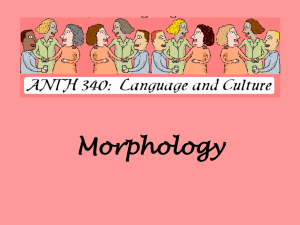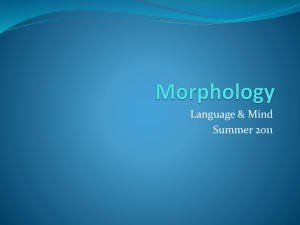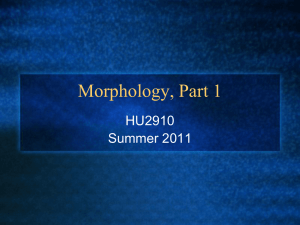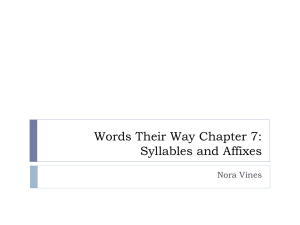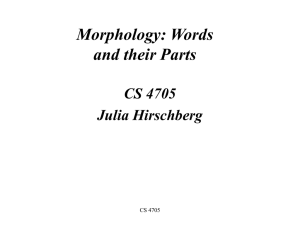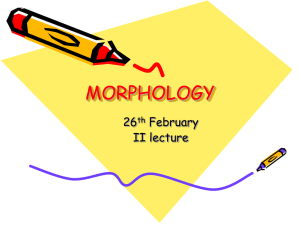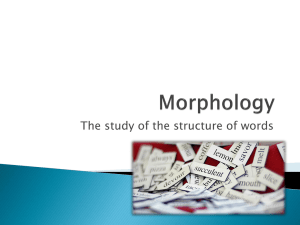Morphology
advertisement
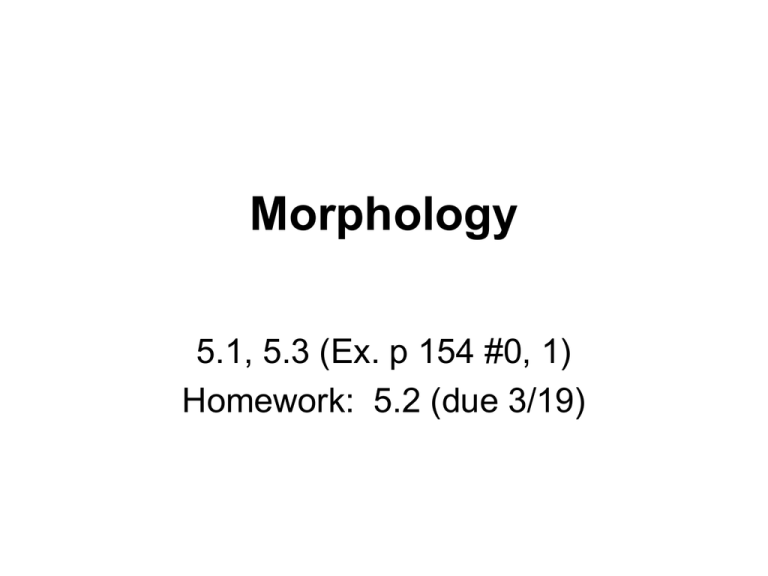
Morphology 5.1, 5.3 (Ex. p 154 #0, 1) Homework: 5.2 (due 3/19) Morphology • Up to this point we have studied the sounds of English and how they interact in systematic ways • The next step: Strings of language sounds form units of meaning Morphology • Morphology is the study of how units of meaning are formed Morphology • How many units of meaning are present in the following sentence: my shoes are untied Morphology Or in this sentence: I waited for her all morning Morphology Or in this sentence: those socks are smelly Morphology • *Morpheme — the smallest unit of meaning in a language – i.e., it cannot be subdivided into smaller units of meaning Morphology • We usually think of morphemes as bases/stems affixes Stem • *Base / stem — the meaning unit that affixes attach to This is the core of the word, which has the lexical meaning that is added to in some way by an affix Morphology • *Affixes – attach to bases/stems Affixes • Prefixes attach to the front of a stems or words (in-)sight (dis-)arm (un-)aware Affixes • Suffixes — attach to the end of stems or words try(-ing) examin(-ation) navig(-ate) rect(-ify) Affixes • Infixes – attach in the middle of a word • Karl (-the mailman-) Malone, etc. fan(-f…-)tastic a(-whole-)nother thing Morphology • Through the systematic interaction of morphemes, the units of meaning of a language are formed • Part of what we know when we know a language is how morphemes interact Morphology Some morphemes show variation in use • Colder More beautiful Morphology Adjectives / Adverbs • (-er) ‘more’ • (-est) ‘most’ slower slowest Can we make a descriptive rule for this variation? Morphology • *Allomorph: Variants of morphemes That is, variations in the form of the morpheme, with each form having the same meaning Allomorphs • Plural (-s) morpheme /z/ /əz/ /s/ beds sashes hats • Question: Which is basic plural in English? Allomorphs • • • • Possessive (-s) /z/ Bill’s /əz / Marcus’s /s/ Clark’s Allomorphs • • • • 3Person Singular /z/ reads /əz/ watches /s/ hits Allomorphs *RULE: • after voiced sounds, /z/ • after sibilants, /əz/ • after other voiceless sounds /s/ [sound familiar?] More Allomorphs • Past tense (–ed): /d/ /t/ feared, burned, cried wished, kissed [for some, burnt, learnt] /əd/ heated, mended More Allomorphs RULE: after voiced sounds, /d/ after voiceless sounds, /t/ after alveolar stops, /ed/ Allomorphs • We can see that many allomorphs in English are phonologically conditioned — Their form is determined by neighboring sounds • Cf. Spanish: amigos (in Spanish, no such conditioning) Allomorphs Other allomorphs in English: • pres. part. (-ing) [ən], [iŋ] ‘playing’ free variation (only stylistic variation) Allomorphs • • • • • Unlike Inactive Impossible Illogical Irreversible • What rule produced these allomorphs? Morphology • Lexical categories: I. Content words: have lexical meaning II. Grammar words: provide primarily grammatical information Lexical categories • I. *Content words (form class words) Content (form class) words change form to fit into the grammar — pitch (V.) → pitcher (n.) Content words 1. Constitute most of vocabulary — by far the greatest number of words Content words (form class words) 2. Have lexical meaning — that is, they mean something — table, floor, eat (Nouns, Verbs, Ajs., Avs.) Content words (form class words) 3. Open category: New ones can come into the language at any time — CDRom; mouse; blog; google; mcjob Lexical categories • II. *Grammatical (function class) words 1. Smallest part of vocabulary — only a small fraction of words Grammatical (function class) words 2. Primarily grammatical meaning — and, but, on, under, who, etc. These not so much mean things as signify grammatical relationships Grammatical (function class) words 3. Closed class — unchanging grammatical structure words No new ones Morphology • Content (Form Class) words in English may take inflectional morphemes or derivational morphemes *Inflectional morphemes 1. Contain grammatical information 2. Do not change word class 3. Suffixes only Inflectional morphemes Inflectional morphemes of English: N — pl. (-s) two shoes – p possessive (-s) a dog’s breakfast Inflectional morphemes V— 3 person sing. –s She eats at noon. –pres. participle –ing are eating –past tense (-ed) earned $20 –past participle (–en) has eaten [includes (-ed), vowel change] Inflectional morphemes Adj / Adv— (-er) slower (-est) slowest English has these 8 exactly Derivational morphemes • *Derivational morphemes of English participate in deriving new words 1. Change word meaning — (im-) port (un-) do Derivational morphemes 2. Can change word class • • • • • (-er) driv-er, can open-er noun making (-ation) inform-ation noun making (-ize) real-ize verb making (-al) individu-al adjective making (-ious) delic-ious adj. making Derivational morphemes 3. May be suffix or prefix (un-)like(-ly) (im-)practic(-al) Morphology *Word Formation — • Note sequence in which morphemes are attached to stems and words: Smell-y Tie → un-tie → un-tie-d form → re-form → re-form-ation Veri-fy → veri-fi-able → un-veri-fi-able Word formation Native speakers of a language know which combinations are possible and which are actual ?saltish crackers ?sugary cookies ?three-years-old girl Inflection vs. Suppletion Contrast Spanish and English verb patterns: • Spanish ser conjugation Yo soy nosotros somos Tu eres (vosotros sois) ustedes son El es ellos son Suppletion • The English be verb paradigm: – I am – You are – He / she / it is we are you are they are demonstrates suppletion — separate items used to produce forms in a grammatical pattern Suppletion More examples in English: go / went person / people good / better bad / worse Word formation • These elements of word formation are an important component of the fundamental, complex knowledge we have of our language
